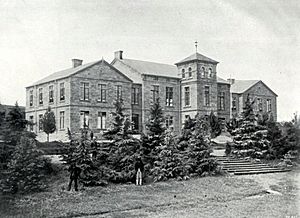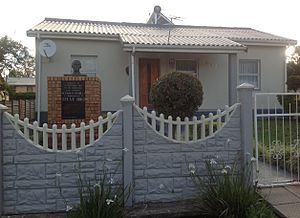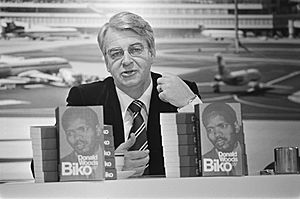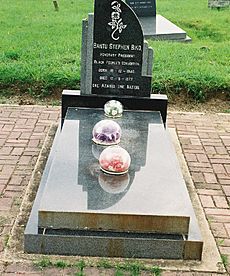Steve Biko facts for kids
Quick facts for kids
Steve Biko
|
|
|---|---|
 |
|
| Born |
Bantu Stephen Biko
18 December 1946 Tarkastad, Eastern Cape, South Africa
|
| Died | 12 September 1977 (aged 30) |
| Cause of death | Extensive brain injuries sustained from beatings by South-African security officers |
| Resting place | Steve Biko Garden of Remembrance, King Williams Town, Eastern Cape, South Africa |
| Occupation | Anti-apartheid activist |
| Organisation |
|
| Spouse(s) |
Ntsiki Mashalaba
(m. 1970) |
| Partner(s) | Mamphela Ramphele |
| Children | 5, including Hlumelo |
Bantu Stephen Biko (born December 18, 1946 – died September 12, 1977) was a brave South African activist. He fought against a very unfair system called apartheid. Apartheid was a set of laws that separated people based on their race, giving white people more rights and power.
Biko was a leader in a movement called Black Consciousness Movement in the late 1960s and 1970s. This movement helped black people in South Africa feel proud of who they were. His ideas were shared in articles he wrote using the pen name Frank Talk.
Steve Biko grew up in a poor family in a township called Ginsberg. He studied medicine at the University of Natal. He saw that many anti-apartheid groups were led by white people, even though black people were most affected by apartheid. Biko believed that black people needed to organize themselves to fight for their own freedom. He helped create the South African Students' Organisation (SASO) in 1968. This group was only for "black" people, which to Biko meant not just African people, but also Coloured and Indian people in South Africa. He wanted black people to be strong and independent, but he was not against white people.
Biko and his friends developed the idea of Black Consciousness. This idea taught black people to believe in themselves and their own worth. They used the slogan "black is beautiful" to help people feel proud. In 1972, he helped start the Black People's Convention (BPC) to spread these ideas even further. The government saw Biko as a threat. In 1973, they placed a "banning order" on him, which severely limited what he could do and where he could go.
Even with the ban, Biko continued his work. He helped set up community projects like a healthcare center and a daycare. He was arrested several times by the police. In August 1977, he was arrested again and sadly died from injuries he received while in police custody. More than 20,000 people attended his funeral.
After his death, Steve Biko became even more famous. Many songs and artworks were made about him. A book written by his friend Donald Woods was made into the movie Cry Freedom. Biko is remembered as a hero and a "Father of Black Consciousness."
Contents
Steve Biko's Early Life and Education
Steve Biko was born on December 18, 1946, in Tarkastad, Eastern Cape. He was the third child of Mzingaye Mathew Biko and Alice 'Mamcete' Biko. His father worked as a police officer and later as a clerk. His mother worked as a domestic helper and a cook. Steve saw how hard his mother worked, which made him think about fairness from a young age.
Biko's first name, "Bantu," means "people" in his language, IsiXhosa. He believed it meant "a person is a person by means of other people." As a child, he was very smart and even skipped a year in school. In 1964, he went to Lovedale, a well-known boarding school. However, he was expelled after his brother was wrongly accused of being involved with a banned political group. This experience made Biko dislike unfair authority.
From 1964 to 1965, Biko studied at St. Francis College, a Catholic school. Here, he became more interested in politics. He wanted South Africa to have a government that truly represented its black majority. He admired leaders who fought against colonial rule. Even though his family supported a group called the Pan Africanist Congress (PAC), Biko believed that all racial groups should work together against the government.
Steve Biko's Student Activism
Biko first wanted to study law, but his friends encouraged him to study medicine instead, thinking it would lead to a better career. In 1966, he started medical school at the University of Natal. He quickly joined the Students' Representative Council (SRC).
The SRC was part of the National Union of South African Students (NUSAS). NUSAS tried to include all races, but it was mostly led by white students. Biko and other black students felt frustrated because NUSAS didn't fully understand the black experience. For example, at a NUSAS conference in 1967, white and Indian students had dorms, but black students were told to sleep in a church. Biko and others walked out in protest.
Creating the South African Students' Organisation (SASO)
After this, black students decided to form their own group. In July 1969, the South African Students' Organisation (SASO) was officially started. Biko played a big part in creating SASO. He was elected its first president. SASO focused on connecting black students across South Africa through sports, culture, and debates.
Biko and other black student leaders developed the idea of "Black Consciousness." This idea was about black people seeing themselves as worthy and proud. It meant rejecting the idea that they were inferior. Black Consciousness included not only African people, but also Indian and Coloured people, calling them all "black." Biko explained that "black is beautiful" meant "Man, you are okay as you are. Begin to look upon yourself as a human being."
Biko wrote about his ideas in the SASO Newsletter under the name "Frank Talk." He traveled to different universities to share these ideas and recruit students. After a year, he stepped down as president. He wanted new leaders to emerge so that the movement wouldn't depend on just one person.
SASO decided to be separate from NUSAS. This was difficult for many white liberal students who believed in multi-racial groups. However, the government, which liked racial separation, was happy about SASO's creation.
Biko's Views on White Liberals
The Black Consciousness Movement (BCM) often criticized white anti-racist liberals. Biko felt that while white liberals meant well, they sometimes acted in a way that showed they didn't fully understand the black experience. He believed they were trying to ease their own consciences rather than truly helping black people gain power.
Biko argued that white people, even those against apartheid, still controlled the anti-apartheid movement. He felt that black people needed to lead their own fight. He clarified to his friend Donald Woods, a white liberal editor, that he didn't reject white liberals themselves. Instead, he rejected the idea that white liberals should lead the black liberation movement. He saw them as friends, but believed their approach was "too gentle" for the struggle.
In 1972, Biko was no longer allowed to study at the University of Natal due to his focus on activism.
Black Consciousness Activities and Biko's Banning
In 1971, Biko helped form the Black People's Convention (BPC). This group aimed to spread Black Consciousness ideas to more people beyond students. The BPC was officially launched in 1972.
Black Consciousness activists also started Black Community Programmes (BCPs). These programs focused on improving healthcare and education for black people. They also helped black communities become more self-reliant. Biko believed that community development was a way to make black people feel proud and dignified.
In 1972, Biko started working for the BCPs. He helped set up a new BCP branch in Ginsberg. This branch offered literacy classes, sewing lessons, and health education. Near King William's Town, they opened the Zanempilo Clinic, a healthcare center for rural black people. He also helped revive a daycare for children of working mothers and created a fund for students. He even helped start a leather goods company to create jobs for local women.
By 1973, the government saw Black Consciousness as a threat. In March 1973, they issued a "banning order" against Biko. This meant he could not leave King William's Town, speak in public, or meet with more than one person at a time. He also couldn't be part of political groups, and the media was forbidden from quoting him. He returned to live in Ginsberg.
Even under the ban, Biko continued his work. He tried to unite different black liberation groups like the BCM, PAC, and African National Congress (ANC). He also started studying law by correspondence. The security services tried to scare him with threats and gunshots at his house. They arrested him four times, once for 101 days.
During his ban, Biko met Donald Woods, a white liberal editor of the Daily Dispatch newspaper. Biko wanted Woods to give the Black Consciousness Movement more coverage. Woods was worried about Biko's earlier writings, which seemed anti-white liberal. Biko admitted some of his earlier words were "overkill" but stood by his main message. They became close friends. Woods later said that Biko helped him understand black oppression deeply.
Steve Biko's Death
In 1977, Biko broke his banning order by traveling to Cape Town. He wanted to meet with another activist and address problems in the BCM's Western Cape branch. On August 18, he and his friend Peter Jones were stopped at a police roadblock near Grahamstown. Biko was arrested for breaking his banning order.
The police took Biko to a police station in Port Elizabeth. On September 6, he was moved to security police headquarters. There, he was interrogated for 22 hours and beaten by police officers. The police later claimed Biko attacked one of them.
Biko was then taken to a prison hospital in Pretoria. Steve Biko died alone in a cell on September 12, 1977. He was the twenty-first person to die in a South African prison in twelve months. His death shocked many people around the world.
Steve Biko's Beliefs and Ideas
Steve Biko's ideas for the Black Consciousness Movement came from discussions with other black students. He was influenced by writers like Frantz Fanon and the Black Power movement in the United States.
Black Consciousness and Empowerment
Biko did not like how the apartheid government divided people into "whites" and "non-whites." He believed "non-white" was a negative term. So, he used the word "black" instead. For him, "black" was a positive term that included all people who were discriminated against in South Africa: African, Coloured, and Indian people. He believed that race, not class, was the main reason for oppression in South Africa.
Biko argued that white people controlled both the apartheid system and the anti-apartheid movement. This left black people feeling powerless. He believed that black people needed to lead their own fight for freedom. He asked white allies to focus on convincing other white people that apartheid would eventually fall.
Biko's main goal was to help black people feel strong and proud. He saw that many black South Africans felt inferior. He said that "the most powerful weapon in the hands of the oppressor is the mind of the oppressed." He wanted black people to overcome their fears and believe they deserved freedom. Black Consciousness was about "infusing people with pride and dignity." This is why the BCM used the slogan "Black is Beautiful."
Community projects were a key part of this empowerment. Biko believed these projects would not only help with poverty but also change society mentally, culturally, and economically. Students helped with school repairs, house-building, and teaching about money and farming. Healthcare was also important, with a focus on basic care.
Views on a Future South Africa
Biko wanted a future South Africa to be a truly non-racial society. He imagined a place where people of all backgrounds could live peacefully together. He supported a "one person, one vote" system, where everyone had an equal say.
He was not a communist or a capitalist. He believed in "African socialism," which meant a fair society where wealth was shared. He thought that if South Africa remained capitalist after apartheid, some black people would become rich, but many would still be poor. He wanted a mixed economy where the state owned land and important industries to ensure social justice.
Biko was sure that the Black Consciousness Movement would not lead to hatred of white people. He said it was "a positive black self-confidence thing involving no hatred of anyone." He believed that a new government would need to educate the black population to live in a non-racial society and prevent any desire for revenge against the white minority.
Steve Biko's Legacy
Steve Biko is seen as the "father" of the Black Consciousness Movement and a very important figure in the fight against apartheid. Nelson Mandela called him "the spark that lit a veld fire across South Africa." Many people believe his death made the struggle against apartheid even stronger. In 2004, he was voted 13th in a public poll of "Great South Africans."
After Biko's death, his writings were published in a book called I Write What I Like. His friend Donald Woods wrote a book about him, Biko (1978), which was made into the movie Cry Freedom in 1987. This movie helped tell Biko's story to a wider audience around the world. The South African government tried to ban books and the film about Biko.
How Steve Biko is Remembered
Many artists honored Biko after his death. Gerard Sekoto created Homage to Steve Biko, and Peter Stopforth made a work called The Interrogators, showing the police officers involved in his death. Kenya even released a postage stamp with his face on it.
His death also inspired many songs. The English singer-songwriter Peter Gabriel released a hit song called "Biko" in 1980, which was banned in South Africa. This song, and others like it, helped spread awareness about apartheid in Western countries. There was also a play called The Biko Inquest based on the investigation into his death.
After apartheid ended, a bronze statue of Biko was put up in East London in 1997. Over 10,000 people attended its unveiling. The cemetery where Biko was buried was renamed the Steve Biko Garden of Remembrance.
In 1997, Biko's family started the Steve Biko Foundation. This foundation opened the Steve Biko Centre in Ginsberg in 2012. They also host an annual Steve Biko Memorial Lecture, where important black thinkers give speeches.
Many places around the world have been named after Biko. In 2008, the Pretoria Academic Hospital was renamed the Steve Biko Hospital. There's also a Steve Biko Institute in Brazil that helps poor Afro-Brazilians with education. In 2012, the Google Cultural Institute created an online archive of documents and photos from the Steve Biko Foundation. On December 18, 2016, Google honored Biko's 70th birthday with a Google Doodle.
Different political groups in South Africa remember Biko in their own ways. Some groups claim he would have supported them. However, Nelson Mandela once said that "Biko belongs to us all, not just AZAPO," meaning his legacy is for everyone in South Africa.
|
See also
 In Spanish: Steve Biko para niños
In Spanish: Steve Biko para niños






